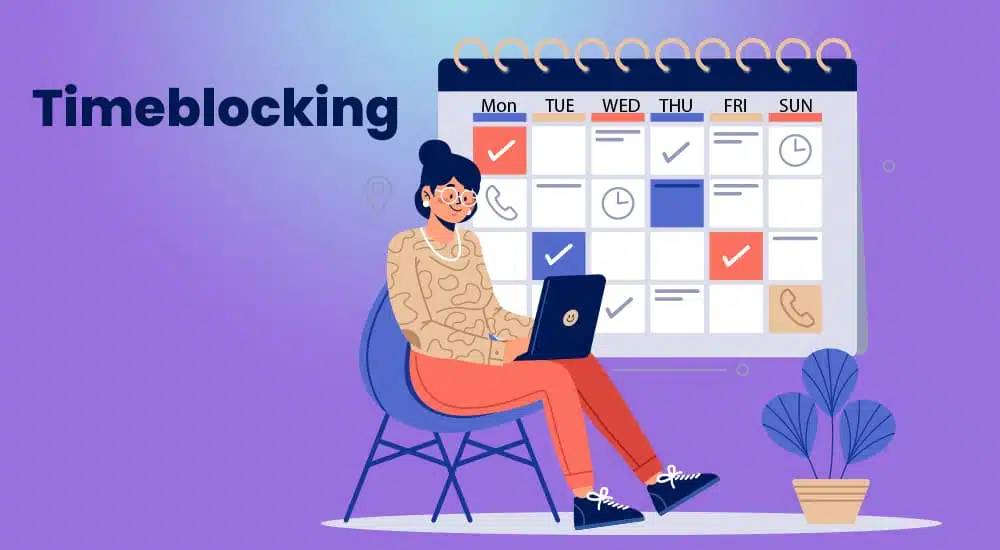We spend most of our time with digital interfaces, which consume a lot of time. Hence effective time management strategies such as Time Blocking become essential.
Time blocking is a transformative strategy for task management and productivity enhancement. With a structured approach, this technique provides a clear visualization time assigned for different tasks and ensures each task gets the focus.
Renowned leaders like Bill Gates and Elon Musk attribute their productivity to effective time blocking. Gates, for instance, allocates his Wednesdays and Fridays to focus on deep, concentrated work, while Musk divides his entire week into five-minute blocks.
Time Blocking is like a daily “to-do list,” but more fun. With time blocking, you will break the day into smaller parts, like puzzle pieces. Each piece of the puzzle is for a different activity. For example, one piece could be for playing games; another could be watching cartoons.
This article delves into time blocking, benefits, and practical implementation tips.
What is Time Blocking?

Time blocking is a trick to ensure your day is fun and you don’t have to rush through your tasks too much. It turns “to-do” lists into an easily followable schedule.
Imagine chopping a day, a week, or a month into pieces like a pizza. These pieces are called “blocks of time.” Each block is like a special place in the schedule for different things to do, like drawing, playing games, reading, etc.
Developing a time blocking schedule is the process of assigning fun activities to each block of time. You can do it using a notebook or a calendar app. The idea is to organize everything into a time slot. It’s like having a fun day planner.
Time blocking ensures that “important tasks” (e.g., washing the dishes, cleaning a room, or feeding your pet) aren’t forgotten. Focusing on one task at a time is more manageable. This makes the day a lot more fun and less chaotic.
How Does Time Blocking Work?
Time blocking is a time management technique that can increase productivity.
The following process shows how the time blocking method works:
- Concept of Time Blocking: Time blocking is a time management strategy that splits the day into time segments or “blocks,” with each block reserved for a specific task or activity. This method boosts productivity by encouraging focused work and minimizing distractions.
- Task Identification: The first step is identifying all the tasks to accomplish. This can include professional responsibilities, personal errands, etc.
- Estimating Task Duration: Each task is given an estimated completion time. This helps allocate enough amount of time for each task within the schedule and avoids time overruns.
- Scheduling: After identifying tasks and their durations, schedule them for the ‘best times’ of the day. These ‘best times’ vary for each person and depend on individual peak productivity periods. For example, some people may be most productive in the early morning, while others may work best in the afternoon or evening.
- Respecting the Schedule: After setting the time blocks, following them strictly is important. This means dedicating the whole time block to its assigned task, reducing the temptation to multitask or switch between tasks.
- Breaks and Flexibility: Regular recharge breaks are essential to time blocking. This helps maintain productivity levels throughout the day. While the aim is to stick to the time blocked schedule as closely as possible, some flexibility should be maintained to accommodate unforeseen tasks or changes throughout the day.
- Review and Adjust: The final element of time blocking involves regular schedule reviews. There are necessary to adjust and improve productivity and efficiency.
Time blocking is an effective, productivity boosting task-management strategy. The ultimate goal of time blocking is to work smarter by making mindful decisions about how you spend your time.
Does Time Blocking Work?
Time blocking works. It turns a messy to-do list into an organized schedule.
Each task has a “block” or “slot” in the time blocking schedule. Think of each task as having a special place in your daily routine.
There are two types of work: (1) deep work; and (2) shallow work. Deep work (e.g., solving a tough math problem) needs a lot of focus. Shallow work (e.g., tidying your desk) is easier. Time blocking helps you decide when to do deep work and when to do shallow work.
Time blocking can group similar tasks in the same time slot. This avoids the brain fatigue that comes from constantly switching between different tasks.
Time blocking can also incorporate free time or a break in the schedule to relax and recharge. Tools like a Pomodoro timer or apps like TickTick can help manage these breaks.
Time blocking works best when you stick to or adjust the schedule as needed. It is a great way to plan and use time wisely.
Advantages of Time Blocking
Time blocking offers several advantages; it helps you create a roadmap for the day, which can help you navigate different tasks smoothly.
Here are some benefits of time blocking:
- More Productivity: Focusing on a single task helps avoid distractions. This increases the output.
- Better Time Management: Time blocking gives each task its own time slot and cordons it off from the rest of the tasks. This helps you manage the day effectively and keep track of every task on your schedule.
- Less Multitasking: Assigning a specific time block to each task means less multitasking. It helps you focus on one task before moving on to the next.
- Helps You Remember Important Tasks: Time blocking gives important tasks their own time slots, thus ensuring that they don’t get lost amongst your other to-do list items.
- Better Focus: Time blocking helps block out time for deep work, thus allowing you to give your full attention to a particular task. This helps you get things done more accurately and efficiently.
- Better Work/Play Balance: Time blocking also sets aside time for relaxation and hobbies. This enables a good balance between work and play.
- Less Stress: Splitting the day into manageable blocks of time makes the day seem less daunting. It is like having a roadmap guiding each step of the day.
- Helps You Group Similar Tasks: Similar tasks can be grouped in the same time slot with time blocking. For example, all math homework can be done at once, or all the cleaning chores at another time.
- Better Planning: Time blocking helps you plan the day and achieve your goals. It helps you stay organized and make progress.
- Easier to Follow: Time blocking shows how the day is planned. This roadmap of the day can help you stay on track and complete tasks. Time blocking can also be done with tools like Google Calendar to make it even more effective!
Common Time Blocking Mistakes
When you manage time blocking errors and obstacles, you can more successfully implement this robust time management method.
The following are the potential obstacles you may encounter while time blocking:
- Overloading the Time Blocked Work Week: Squeezing many tasks into your blocked hours can diminish your output and induce stress. Balancing your workload is the key to effective time blocking.
- Misjudging Task Duration: Estimating task duration is crucial. Underestimating the time required may lead to missed deadlines and work piling up, affecting the entire schedule.
- Avoiding Breaks: The Pomodoro Technique is another popular time management method that emphasizes the importance of breaks. If you don’t incorporate rest into your time blocked schedule, it may lead to fatigue, thus reducing overall productivity.
- Ignoring Flexibility: Life is full of unexpected events. A rigid time blocked schedule with no room for adjustments can become a hindrance rather than a productivity tool.
- Failing to Prioritize: All tasks are not equal. Neglecting to prioritize tasks based on their importance and deadlines can result in key tasks being overlooked.
- Inconsistent Synchronization: Time blocking is most effective when personal rhythms align with the task schedule. Ignoring one’s peak productivity periods can reduce efficiency.
- Lack of Review and Adaptation: Regular review and adjustments help ensure an effective time blocking schedule. This also helps avoid repeating the same scheduling mistakes.
Time Blocking Tips
Here are some tips on how to start time blocking today:
- Find Your Rhythm: People are productive at different times. Understanding this rhythm and scheduling the most important tasks during this peak productivity time is important.
- Use the 80/20 Rule: Not all tasks are equal. Some tasks provide more results than others. The 80/20 rule suggests that 20% of tasks will provide 80% of the results. Identify these tasks and prioritize them in the schedule.
- Blend the Old and the New: A physical planner can help visualize the day’s schedule, while digital tools can send reminders when it’s time to switch tasks or when a deadline is approaching.
- Don’t Forget to Relax: Adding short breaks after every intense work session is important. Longer breaks for meals are also important. This helps avoid becoming too tired and maintains a healthy balance between work and rest.
- Make Time for Reflection: Consider what worked well and what didn’t get accomplished at the end of each day. This will help adjust your plan for the next day.
- Protect Your Time Blocks: Protect the time blocks from distractions. This might mean setting the phone to “do not disturb” or letting others know not to interrupt during a certain time.
- Be Ready to Adjust: Sometimes, a task takes longer than planned. It is important to be flexible and ready to adjust the schedule when needed.
Time blocking isn’t about making a perfect schedule but constructing a structure that focuses on the most critical tasks. Scheduling free time is equally as important as scheduling work time.
Some people find it helpful to have different themes for different days, like Mondays for planning and Tuesdays for deep work. Google Calendar or Outlook can help you create and manage these time blocks. The goal is to create a balanced schedule that works best.
Conclusion
The time blocking approach goes beyond simple task batching, offering a sense of control over the schedule and promoting a healthier work-life balance. With the right tool, such as Gmail’s calendar, time blocking becomes even more seamless, allowing quick adjustments and reminders. Setting up the time blocks with templates save time, and you can reuse effective schedules for similar tasks.

I am Mohammad Fahad Usmani, B.E. PMP, PMI-RMP. I have been blogging on project management topics since 2011. To date, thousands of professionals have passed the PMP exam using my resources.







